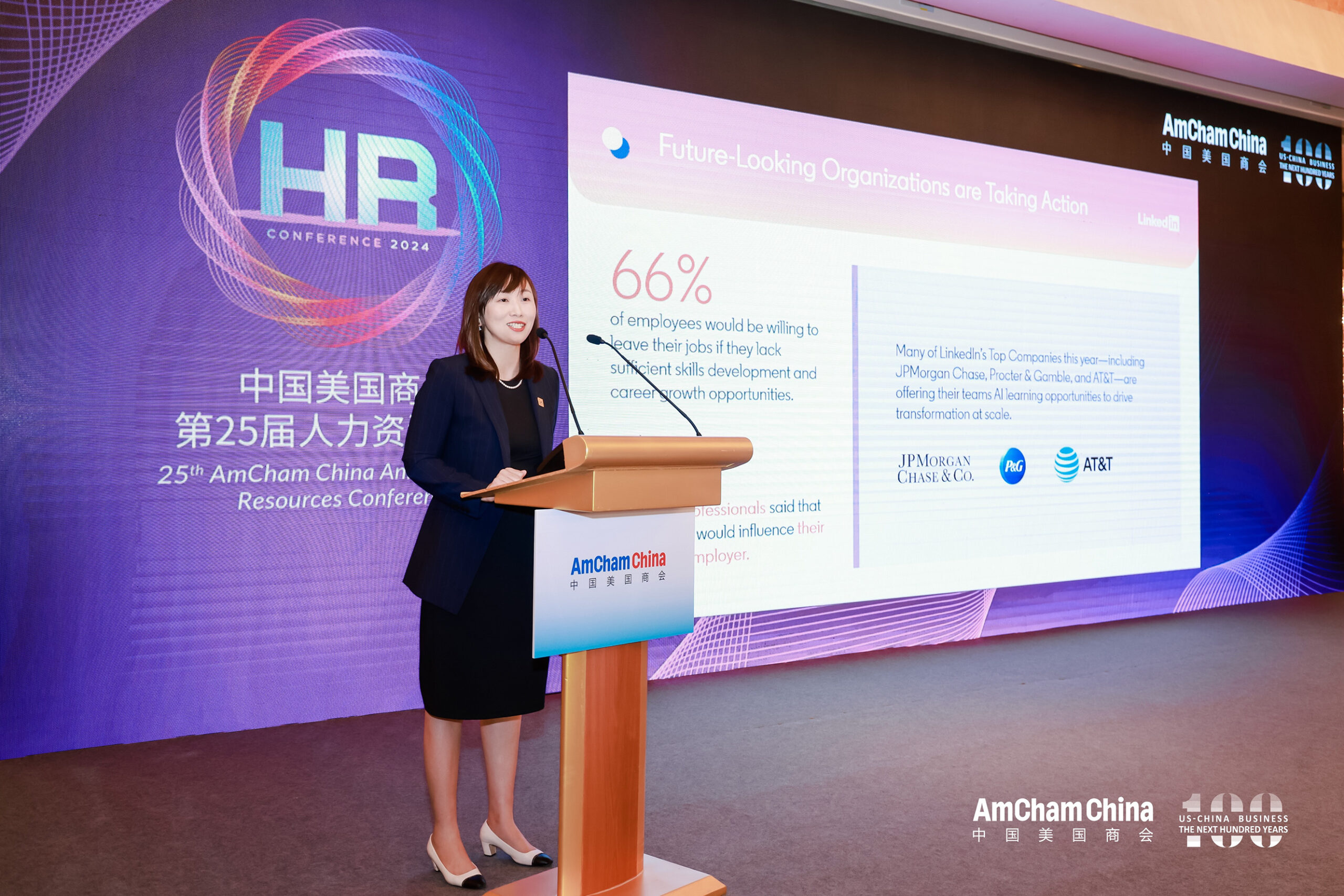From Local to Global: The New Talent Strategy
In the rapidly evolving landscape of Chinese enterprises, the slogan “If we don’t go global, we won’t survive” has become a rallying cry. Nancy Wang, Country Manager of LinkedIn China, has been at the forefront of this transformative era, guiding businesses through the complexities of international expansion. Over the past decade, Wang and her team have played a crucial role in reshaping the talent strategies of Chinese companies, helping them to navigate the fierce global competition. In this article, Wang shares insights into the significant shifts in talent acquisition and development, and how LinkedIn’s innovative solutions are empowering Chinese enterprises to thrive on the world stage.

Nancy Wang is the China Country Manager and Senior Director of Talent Solutions for Greater China at LinkedIn. Joining LinkedIn in 2019, she now leads a team overseeing strategy, sales, marketing, business development, and customer success for LinkedIn in Mainland China, Hong Kong, and Taiwan.
With over 20 years of experience, Wang has held key management positions at companies like Microsoft and Oracle. Before LinkedIn, she was President of Trax Greater China, where she developed and implemented the company’s market strategy.
Her leadership and strategic vision have earned her prestigious awards, including “Fortune China’s Most Influential Businesswomen” and “36Kr SHE POWER·2023 Influential Women”. These accolades highlight her contributions to connecting Chinese enterprises with global opportunities and advancing women’s empowerment. She holds a Bachelor’s degree in International Economics and Trade from Shanghai Jiao Tong University.
Photo courtesy of LinkedIn China
At the beginning of 2024, many Chinese enterprises adopted the mindset, “If we don’t go global, we won’t survive,” demonstrating their determination to expand internationally. This has proven to be true. From intelligent manufacturing and photovoltaics to consumer-oriented industries like gaming, e-commerce, and entertainment, and even emerging AI applications, we are seeing more and more companies feeling the pressure to “go global” to beat out fierce competition.
According to recent statistics, nearly 96,000 Chinese enterprises currently operate overseas, and the demand for recruiting overseas talent has reached 4.5 million people. By 2026, the market for overseas talent recruitment is expected to reach 8.4 billion US dollars. Last year, a report jointly released by LinkedIn and MIT Technology Review highlighted that the demand for overseas talent in four emerging hot fields—smart hardware, industrial robots, healthcare, and new energy—is continuously growing. Over 95% of these enterprises have already started localized overseas operations.
As global expansion becomes a necessity and localized operations a crucial factor in determining success or failure, the talents required by enterprises are no longer limited to those with merely overseas experience. LinkedIn, which has been in China for ten years, has witnessed and experienced the evolution of Chinese enterprises’ talent outlook for global expansion.
In 2014, LinkedIn established its first office in China, fully launching its business in the country. LinkedIn introduced two brand-new concepts—”professional networking” and the “economic graph”—to the Chinese market and played a crucial role as a “guide” for Chinese enterprises seeking to expand globally. By providing enterprises with the necessary overseas talent profiles and one-stop global talent solutions, LinkedIn helped Chinese enterprises effectively enhance the impact of their talent strategy on global business development. This, in turn, gave them more confidence and momentum to participate in global competition.
The Shift to Long-Term Talent Strategie
Ten years ago, a group of Chinese ventures took their first steps toward global expansion, achieving numerous “firsts” through LinkedIn. From pinpointing locations and recruiting key talent for their overseas R&D centers to securing highly skilled technical professionals and identifying ideal candidates for aiding in their global business expansion, LinkedIn supported these organizations throughout every stage of the process, aiding their growth and expansion worldwide.
“Over the past 10 years, we have witnessed a profound change in the talent outlook of Chinese enterprises expanding globally,” says Nancy Wang, Country Manager of LinkedIn China. “In the initial years, most of the overseas recruitment requests received by the LinkedIn China team were vague. However, in recent years, the demands and starting points of enterprises have become increasingly clear and in-depth. They have clearer talent plans for the local market, pay more attention to the precise matching of positions and business needs, and focus on building a longer-term overseas employer brand and talent pipeline.”
Data supports this evolution. Numerous enterprises began collaborating with LinkedIn between 2014 and 2015, and their investments have since surged. For example, the number of recruitment listings on LinkedIn has grown exponentially, increasing by over 30% year-over-year. This growth has enabled organizations to effectively connect with crucial talent pools, spanning tech innovators, overseas management, and Gen-Z candidates.
The Global Talent System: A “Skills-Oriented” Approach and “Continuous Learning”
Another notable shift in the talent strategy of Chinese organizations expanding globally is their focus on a “talent development perspective” to attract and retain top talent. According to LinkedIn’s research, the two key factors for Chinese enterprises in attracting top talent in 2024 are offering opportunities for skill development and career growth (54%) and emphasizing the company’s vision and goals in the AI era (51%). Particularly for enterprises with overseas operations, the primary factor in attracting top talent is providing a sustainable development platform, surpassing even salary considerations.
In response to shifting demand trends, LinkedIn proposes a “skills-oriented” and “continuous learning” solution for Chinese enterprises. LinkedIn data indicates that by 2030, 68% of global workplace skills will undergo disruption. In 2023, LinkedIn research identified over 500 skills potentially influenced by generative AI technology. With skill supply and demand trends becoming increasingly unpredictable, how can global enterprises enhance job-person matching? The initial step involves embracing a “skills-first” talent recruitment strategy.
In 2019, LinkedIn pioneered the “skills-first” talent concept worldwide and developed the world’s first “Skills Graph.” Leveraging data from one billion professional profiles, job postings from 67 million companies, and over 40,000 skill tags on its platform, LinkedIn enables enterprises to stay attuned to global labor market dynamics and foster sustainable growth focused on “skills.”
To provide career advancement opportunities for top talents, enterprises should build effective organizational learning and development mechanisms that align with employees’ career aspirations. In 2023, LinkedIn Learning solutions was launched in the Chinese market, creating an intelligent skill enhancement platform for Chinese enterprises. With generative AI support, LinkedIn Learning provides employees with a unique, self-driven, and customized learning experience.
Since its launch, LinkedIn Learning has garnered global recognition. In the past six months alone, the number of non-technical professionals using LinkedIn Learning to enhance their AI skills has sky rocked by 160%. With this success, LinkedIn Learning’s mission in China is clear: Help enterprises build learning organizations, enabling Chinese professionals to stay ahead in the rapidly changing labor market; and assist enterprises in building dynamic cross-cultural teams and empowering their globalization efforts.
“Leaders who prioritize agility and invest in skill development gain a competitive edge by fostering an equipped workforce that is ready for AI.”

Above: Nancy Wang delivers a keynote at AmCham China’s 25th Annual HR Conference
Photo courtesy of LinkedIn China
AI: A Productive Force for Enterprises and a Talent Magnet
AI is reshaping the business landscape by enhancing access to information and optimizing efficiency. Yet, the skill shifts driven by AI and digitization present multifaceted challenges in terms of talent supply and demand, talent development, and individual career trajectories within enterprises.
Recently, Microsoft and LinkedIn unveiled the “2024 Work Trend Index on the State of AI at Work,” highlighting a pervasive “AI-driven work revolution” permeating from grassroots levels. Over the last six months, the global workforce adopting generative AI at work has nearly doubled, while the number adding AI skills to their LinkedIn profiles has surged by 142 times. Furthermore, 75% of knowledge workers worldwide have utilized AI tools in their roles, with this percentage soaring to 91% in China. Among these users, 78% integrate AI tools into their daily workflow.
However, while employees eagerly embrace AI, corporate managers are hesitant. Only 38% of executives stated they are “helping employees improve their AI capabilities,” and just 25% of companies plan to provide relevant training in 2024.
“Corporate managers are at a crossroads with AI – they recognize its potential but are unclear about the direction and goals of AI investment,” explains Nancy Wang. “Learning how to utilize AI and digital technology is highly relevant to Chinese as they seek to deepen their global footprint. Companies must activate the power of talent by providing more ‘AI opportunities,’ utilizing AI technology to foster business innovation, and empowering employees with the chance to learn AI skills and apply AI tools effectively in practice.”
Some forward-looking global companies are already taking action. Many companies on LinkedIn’s Top Company list in 2024 are offering AI skills learning opportunities for their teams. According to surveys of AI super-users, these companies provide enhanced opportunities (over 37%) for employer-sponsored AI training. This includes courses covering natural language processing, data analysis, and practical applications of AI in daily work environments.
With the integration and empowerment of Microsoft and LinkedIn’s advanced technology, including unique generative AI models, LinkedIn is pioneering innovative approaches in talent recruitment and development, giving enterprises a competitive edge. For instance, LinkedIn Recruiter 2024 leverages generative AI to offer optimization suggestions for talent searches and intelligent recommendations. Recruiters can also craft personalized recruitment messages tailored to candidates’ job preferences, effectively identifying high-quality candidates from a diverse talent pool.
“For Chinese companies, understanding local national conditions, business dynamics, and interpersonal relationships is essential for successful overseas localization,” explained Nancy Wang. “This requires talent with ‘global vision’ and ‘localization capabilities.’ The trend of overseas talent supply and demand is accelerating, and whether acting as ‘explorers’ or ‘undercover agents’ in foreign markets, they require a ‘guide.’ With insights drawn from one billion professionals globally and a comprehensive global solution, LinkedIn remains at the forefront, guiding Chinese companies forward.”
The shift towards global expansion among Chinese enterprises is imperative for their survival and success in today’s competitive landscape. With LinkedIn’s innovative solutions supporting them, companies are reaping rewards from AI-driven strategies that enhance talent acquisition and development. As organizations navigate these challenges and opportunities, LinkedIn remains a crucial partner, empowering businesses to adapt, innovate, and thrive on a global scale.

This article is from the AmCham China Quarterly Magazine (Issue 2, 2024). To access the entire publication for free, sign up on our member portal here.


